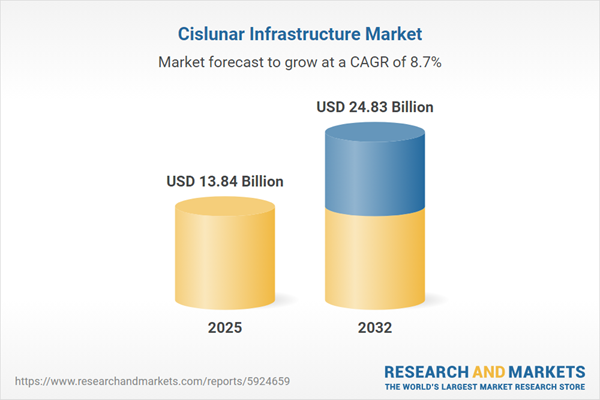Speak directly to the analyst to clarify any post sales queries you may have.
The cislunar infrastructure market is undergoing rapid evolution as both sovereign and commercial players intensify efforts to develop sustainable lunar logistics and operational networks. This growth, driven by public-private partnerships and advancing technologies, is fundamentally reshaping strategic interests between Earth and the Moon.
Market Snapshot: Cislunar Infrastructure Market Size and Outlook
The Cislunar Infrastructure Market grew from USD 12.78 billion in 2024 to USD 13.84 billion in 2025. It is expected to continue growing at a CAGR of 8.66%, reaching USD 24.83 billion by 2032. This steady expansion reflects heightened investments in modular architectures, logistics, and propulsion systems essential for sustained lunar operations and strategic national initiatives.
Scope & Segmentation
- Components: Aeroshell, Electric Propulsion Unit, Logistics Package, Lunar landers, Propellant Tanker/OTV
- Technologies: Communication Satellites, In-Space Transportation Vehicles, Space Stations
- Modules: Communication Infrastructure, In-Space Services & Logistics, Power Generation & Storage, Space Transportation & Propulsion, Staging & Operations Platforms
- Applications: Defense & Security (Space Weapon Systems, Surveillance Technology), Mineral Extraction (Regolith Processing, Resource Mapping), Scientific Research (Astrobiology, Low Gravity Experiments)
- End Users: Government Agencies, Private Enterprises, Research Institutions
- Regions: Americas (United States, Canada, Mexico, Brazil, Argentina, Chile, Colombia, Peru), Europe, Middle East & Africa (United Kingdom, Germany, France, Russia, Italy, Spain, Netherlands, Sweden, Poland, Switzerland, United Arab Emirates, Saudi Arabia, Qatar, Turkey, Israel, South Africa, Nigeria, Egypt, Kenya), Asia-Pacific (China, India, Japan, Australia, South Korea, Indonesia, Thailand, Malaysia, Singapore, Taiwan)
- Companies: Advanced Space, LLC, Airbus SE, ArianeGroup SAS, Astrobotic Technology, Inc., Blue Origin Enterprises, L.P., China National Space Administration, European Space Agency, Firefly Aerospace Private Limited, General Atomics, GITAI USA Inc., Intuitive Machines, Inc., ispace,inc., Leidos Holdings, Inc., Lockheed Martin Corporation, Maxar Technologies Holdings Inc., Momentus Inc., Moon Express Inc., National Aeronautics and Space Administration, Northrop Grumman Corporation, Quantum Space, LLC, Rocket Lab USA, Inc., Roscosmos State Corporation, Safran S.A., Sierra Nevada Corporation, Space Exploration Technologies Corp., Telespazio S.p.A., Thales Group, The Boeing Company, Viasat Inc.
Key Takeaways: Strategic Trends in the Cislunar Infrastructure Market
- Investments are shifting toward modular platform architectures to facilitate incremental mission upgrades and support rapid adaptation strategies in cislunar operations.
- Technology alliances and interoperability standards are increasingly vital to enabling communication, navigation, and resource management across a broad ecosystem of lunar stakeholders.
- Sustainability protocols are influencing supply chain approaches, as reusable systems and debris mitigation are prioritized in new mission designs.
- The competitive landscape is diversifying with the rise of small and medium enterprises introducing niche hardware and software innovations, driving market maturation and increased resilience.
- Emerging regional dynamics are accelerating investment, with North America prioritizing strategic defense programs, while nations across Asia-Pacific advance scientific missions and resource utilization initiatives.
- Strategic collaborations, particularly between government agencies and private entities, are proving essential for cost efficiency, risk reduction, and long-term infrastructure scalability.
Tariff Impact: 2025 Adjustments Affecting Cislunar Supply Chains
The 2025 United States tariff adjustments on key components such as propulsion units and high-performance alloys have introduced procurement challenges, prompting organizations to localize manufacturing and navigate extended approval cycles. Companies are responding by adopting agile sourcing models and forming strategic alliances to ensure consistent access to critical inputs and maintain supply chain resilience.
Methodology & Data Sources
This research integrates structured interviews, secondary analysis, and data triangulation to ensure the reliability of cislunar market insights. Inputs were gathered from senior executives, program managers, technical experts, and validated against comprehensive white papers, regulatory data, and industry literature.
Why This Report Matters
- Enables strategic planning by offering a detailed assessment of critical technologies, partnership models, and application strategies within cislunar infrastructure markets.
- Supports robust decision-making with actionable intelligence on supply chain risk management, regional investment shifts, and regulatory responses.
- Guides senior leaders seeking to align innovation, procurement, and global partnerships for sustainable leadership in lunar operations.
Conclusion
This report provides a holistic perspective on the evolving cislunar ecosystem, equipping decision-makers with the knowledge to address future challenges and capture new opportunities in lunar infrastructure development.
Additional Product Information:
- Purchase of this report includes 1 year online access with quarterly updates.
- This report can be updated on request. Please contact our Customer Experience team using the Ask a Question widget on our website.
Table of Contents
3. Executive Summary
4. Market Overview
7. Cumulative Impact of Artificial Intelligence 2025
Companies Mentioned
The companies profiled in this Cislunar Infrastructure market report include:- Advanced Space, LLC
- Airbus SE
- ArianeGroup SAS
- Astrobotic Technology, Inc.
- Blue Origin Enterprises, L.P.
- China National Space Administration
- European Space Agency
- Firefly Aerospace Private Limited
- General Atomics
- GITAI USA Inc.
- Intuitive Machines, Inc.
- ispace,inc.
- Leidos Holdings, Inc.
- Lockheed Martin Corporation
- Maxar Technologies Holdings Inc.
- Momentus Inc.
- Moon Express Inc.
- National Aeronautics and Space Administration
- Northrop Grumman Corporation
- Quantum Space, LLC
- Rocket Lab USA, Inc.
- Roscosmos State Corporation
- Safran S.A.
- Sierra Nevada Corporation
- Space Exploration Technologies Corp.
- Telespazio S.p.A.
- Thales Group
- The Boeing Company
- Viasat Inc.
Table Information
| Report Attribute | Details |
|---|---|
| No. of Pages | 195 |
| Published | November 2025 |
| Forecast Period | 2025 - 2032 |
| Estimated Market Value ( USD | $ 13.84 Billion |
| Forecasted Market Value ( USD | $ 24.83 Billion |
| Compound Annual Growth Rate | 8.6% |
| Regions Covered | Global |
| No. of Companies Mentioned | 30 |









